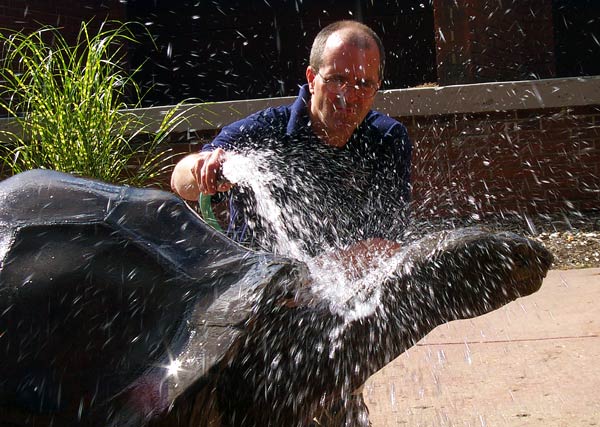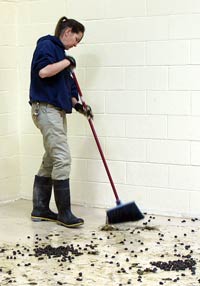
What You See Is Worth Discussing
The best way to determine if your safety training is staying with employees when they’re in the field is to watch them in action. Field observation is a powerful way to reinforce and encourage proper procedures, as two PDRMA members have discovered.
When Yvonne Strode says her workplace at the Pleasure Driveway and Park District of Peoria is a zoo, she means it. As manager of the Peoria Park Zoo, she monitors unique safety scenarios as manager of the Peoria Park Zoo — from dealing with excited giraffes to exiting a tiger exhibit.
 “Our 12 zookeepers are so focused on animal safety. They always remember to lock and close doors, but non-animal-related safety isn’t second nature yet,” Strode explains. “The zoo also has many visitors, and we have to focus on their safety as well.” “Our 12 zookeepers are so focused on animal safety. They always remember to lock and close doors, but non-animal-related safety isn’t second nature yet,” Strode explains. “The zoo also has many visitors, and we have to focus on their safety as well.”
That’s why each week, all seven senior staff members conduct “field trips” to observe employees and suggest safer alternatives if needed — like proper lifting techniques. “We use 50-pound bales of hay to feed the rhinos, giraffes, zebras and donkeys,” she points out. Bending is an integral part of maintaining the enclosures as well as feeding the animals. “There’s a lot of scrubbing and bending needed to keep habitats clean. Each shovelful of rhino waste and mud can weigh as much as 25 pounds, and we have two rhinos!”
 From the exotic (avoiding back strain while cleaning a donkey’s hooves) to the ordinary (good form while entering or exiting vehicles), senior staff observes, comments, and retrains. The managers also document each encounter in a “Zoo Safety Review” database to capture the information, spot trends and take action. From the exotic (avoiding back strain while cleaning a donkey’s hooves) to the ordinary (good form while entering or exiting vehicles), senior staff observes, comments, and retrains. The managers also document each encounter in a “Zoo Safety Review” database to capture the information, spot trends and take action.
“We developed the review after a PDRMA inspection last year revealed we could improve our coaching,” Strode recalls. She analyzes the data from three perspectives: TASK (the job at hand), POSITIVES (what they did correctly), REDIRECT (what was corrected).
“For instance, if the TASK was to add sand, the POSITIVE was using proper form and equipment, and the REDIRECT was to keep good posture even when lifting an empty bucket — because if you need to do it 50 times, you could strain your back,” Strode says.
“With these observations, and the addition of more ergonomics training during our monthly all-staff meeting, I see a lot less ‘bad’ behavior — using the back to lift — and more ‘good’ behavior — stretching before and during work, using 3 Points of Contact,” she explains. “I see employees bending their knees when lifting, and stretching before beginning tasks. And I don’t hear many complaints about back pain.”
Strode notes that visits by Dr. Jim Clapper, PDRMA’s occupational injury prevention consultant, are especially helpful. “He came to the zoo, set up a hay bale and said, ‘I want to see you lift this.’ He also wanted to see how staff got in and out of a pickup truck, and he even had an ergonomic solution to a problem with a tiger door!”
As the weather heats up…
…and you’re observing employees working outdoors, don’t forget to remind them about heat and sun safety. After working for a half hour in the sun, staff should move to another task in the shade, rehydrate with water and avoid drinks with caffeine. Provide coolers so they have access to water wherever they may be working (i.e., buildings, vehicles and equipment). Remind outdoor workers to use sunscreen and to reapply it often to protect against sunburn.
PDRMA Resources
|
Mike Eschenbach, Aquatic Supervisor at the Dundee Township Park District, has also tasked his management staff for the past five years with field observations of some 70 lifeguards, using a comprehensive Internal Lifeguard Audit form that incorporates Core 6.
“Managers observe every lifeguard at least once every two weeks,” he explains. “We look at everything…how they conduct their scans, whether they use the Core 6 strategies, and even whether or not they’re wearing the proper uniform. We look to see if they are proactively guarding their zones with proper head movement in the time allotted. We also make sure they’re rescue ready by creating either an unconscious, spinal, or active rescue drill scenario.”
Lifeguards and managers together review information obtained by observation and video. “We make sure our lifeguards always see their specific observations both by reviewing the unannounced lifeguard audit results with them and showing them their recorded video,” he says. “When we have excellent observations, we like to show the rest of the staff at our weekly in-services, so they know what we’re looking for and what to expect.”
And the lifeguards appreciate the feedback. “We’ve worked hard to create an atmosphere where our veteran staff is very willing and open to helping new staff acclimate to how we work. We also run a ‘Lifeguard of the Week’ program in correlation with the observations we do. Lifeguards get to use a special lifeguard tube for the week, get a new tie-dye shirt, and a lifeguard tube key chain.”
Field observations have helped motivate the lifeguards to be the best they can be, he says, as well as raising the bar for the entire agency.
Whether your staff is performing water-related or more “earthy” job tasks, field observations can help create a safety-focused environment that reduces injuries and protects both employees and patrons. Incorporate regular observations and Core 6 strategies into your agency’s PIPP program, and watch what happens.
PDRMA Resources:
|

